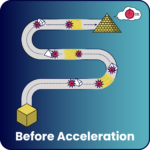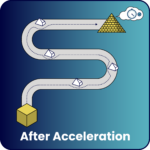 When thinking about enhancing R&D processes, Newton’s second law of motion provides the perfect framework.
When thinking about enhancing R&D processes, Newton’s second law of motion provides the perfect framework.
Classical mechanics teaches us that putting a body into motion requires applying force. The resulting acceleration will be the sum of the forces applied to the body, divided by the body’s mass: a = F/m. So, if we want to accelerate R&D, what are the forces we need to consider? And, what is the mass?
In the lab, positive forces push the research forward. Humans design and run experiments. Machines process and measure samples. Computers run simulations and analyze data.
Frictional forces slow research down. There’s data that’s hard to find, clean, and analyze. Knowledge crucial to the business is trapped in people’s minds. There are long hand-offs between groups to analyze samples. Scientists and engineers with advanced degrees do menial work. There’s essential information shared in unstructured reports. All these things push back against researchers trying to do their job.
All of the steps in the R&D workflow make up the mass. It’s the sequence of operations required to go from a client’s request for a new material to samples sent back to them. It’s the iterative process needed to go from an active compound to a drug trial. These workflows require looking up historical data, exploring literature, and coordinating and communicating across multiple groups. Scientists must mix, shape, and test samples. They must inoculate, measure, and split cultures. Data must be recorded. Reports must be created. Workflows tend to grow in size and complexity. They get heavier and weigh down research.
In many labs, the acceleration is zero – not because work isn't being done, but simply because the positive forces equal the frictions listed above. Organizations can easily settle into a state of equilibrium where any work produced by humans in the lab is met with weighty and slow organizational processes. To combat this zero-sum-game, labs tend to explore ideas using an assembly line approach: research moves at a constant speed with a fixed throughput – slowly passing from one department to the next.
How to Accelerate
Given the previously defined formula for the acceleration of science workflows, a = F/m, there are only two variables that can be altered in an attempt to increase acceleration – the force and mass of R&D.
First, labs can accelerate by applying more positive force. People work harder and longer hours. Managers hire more staff and buy more machines to run more experiments. I.T. acquires more powerful computers. In our experience, pushing harder and spending more money is rarely a viable option.
Second, labs can accelerate by decreasing negative force. Reducing friction offers many possibilities. Individuals can embrace digital science and learn skills to automate repetitive analyses. Labs can invest in analytics-ready data: data that are searchable, accessible, and structured such that it makes sense to scientists. Scientists can use machine learning and deep learning to formalize and automate decision-making. Reducing friction has the lowest barrier to entry and the lowest risk. Everybody loves less friction. In addition to saving time and money, it creates margin. People need margin to innovate. Organizations need margin to implement more impactful changes.
Finally, changing workflows—reducing their mass—often yields the most significant acceleration. A single person’s workflow can be streamlined, once again creating margin. But the biggest payoff comes from looking at the bigger picture: the workflow of an entire lab or business unit. That’s when it can be reconfigured and optimized using the latest technological advances. With a smaller mass, not only is it easier to accelerate, but it’s also easier to change direction. You get speed and agility.
Pragmatic Acceleration
 Accelerating R&D starts with mapping out your existing workflows and their impediments. Once you have the map, you can make sound decisions about reducing friction or mass. Is there a particular step in a person’s workflow that is redundant, slow, and/or error-prone? Consider reducing the friction by training this individual to utilize digital tools for automation. Is there a workflow that involves multiple back-and-forth communications between departments to make final decisions on how to move forward in research? Evaluate the need for each of these communication efforts and explore batch processing requests or testing a new software solution to lessen the burden and hindrances for quickly moving forward by reducing the mass.
Accelerating R&D starts with mapping out your existing workflows and their impediments. Once you have the map, you can make sound decisions about reducing friction or mass. Is there a particular step in a person’s workflow that is redundant, slow, and/or error-prone? Consider reducing the friction by training this individual to utilize digital tools for automation. Is there a workflow that involves multiple back-and-forth communications between departments to make final decisions on how to move forward in research? Evaluate the need for each of these communication efforts and explore batch processing requests or testing a new software solution to lessen the burden and hindrances for quickly moving forward by reducing the mass.
To truly accelerate science, consider the net forces acting on your workflow and determine how much mass your processes require. If you can adjust either or these in your favor, you’ll soon find a dramatic improvement in your R&D velocity.
About the Author
Alexandre Chabot-Leclerc, Ph.D., Vice President, Digital Transformation Solutions at Enthought, holds a doctoral degree in electrical engineering and a M.Sc. in acoustics engineering from the Technical University of Denmark and a B.Eng. in electrical engineering from the Université de Sherbrooke.
Related Content
The Emergence of the AI Co-Scientist
The era of the AI Co-Scientist is here. How is your organization preparing?
Understanding Surrogate Models in Scientific R&D
Surrogate models are reshaping R&D by making research faster, more cost-effective, and more sustainable.
R&D Innovation in 2025
As we step into 2025, R&D organizations are bracing for another year of rapid-pace, transformative shifts.
Revolutionizing Materials R&D with “AI Supermodels”
Learn how AI Supermodels are allowing for faster, more accurate predictions with far fewer data points.
What to Look for in a Technology Partner for R&D
In today’s competitive R&D landscape, selecting the right technology partner is one of the most critical decisions your organization can make.
Digital Transformation vs. Digital Enhancement: A Starting Decision Framework for Technology Initiatives in R&D
Leveraging advanced technology like generative AI through digital transformation (not digital enhancement) is how to get the biggest returns in scientific R&D.
Digital Transformation in Practice
There is much more to digital transformation than technology, and a holistic strategy is crucial for the journey.
Leveraging AI for More Efficient Research in BioPharma
In the rapidly-evolving landscape of drug discovery and development, traditional approaches to R&D in biopharma are no longer sufficient. Artificial intelligence (AI) continues to be a...
Utilizing LLMs Today in Industrial Materials and Chemical R&D
Leveraging large language models (LLMs) in materials science and chemical R&D isn't just a speculative venture for some AI future. There are two primary use...
Top 10 AI Concepts Every Scientific R&D Leader Should Know
R&D leaders and scientists need a working understanding of key AI concepts so they can more effectively develop future-forward data strategies and lead the charge...